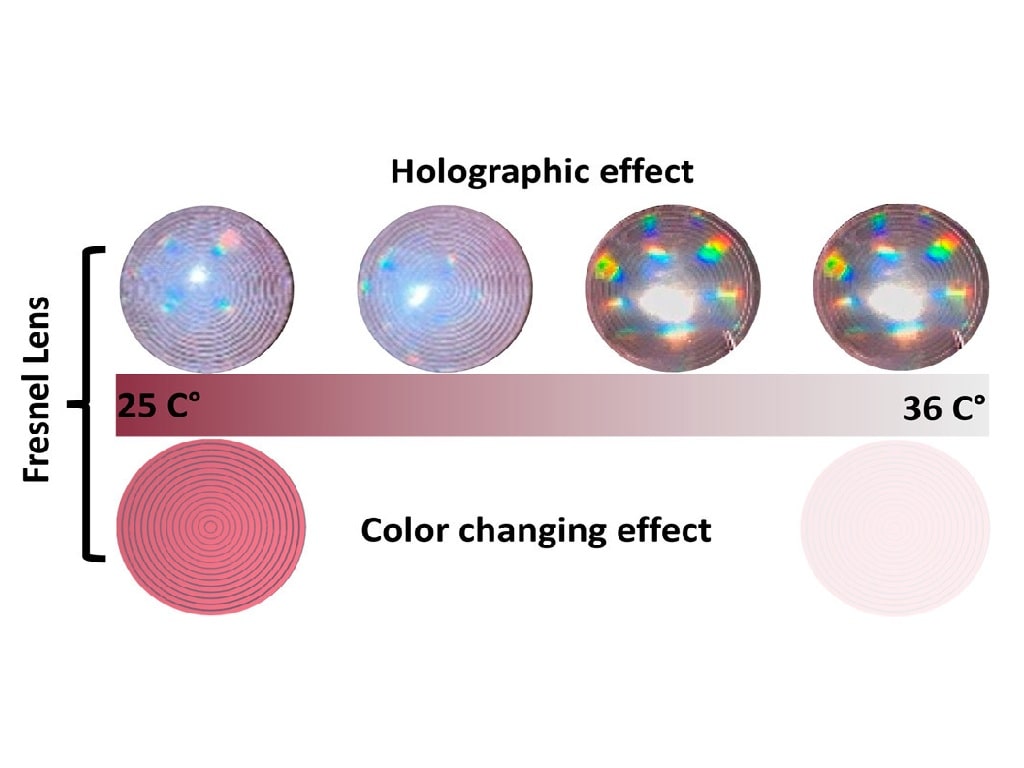
3D printing makes manufacturing regular lenses, and more recently Fresnel lenses, easy and cost-efficient, but now, additive manufacturing can be used to extend their functionality with enhanced optical properties and sensing abilities.
A Khalifa University research team has used additive manufacturing techniques to develop five-dimensional Fresnel lenses, incorporating color-change phenomena and holographic diffraction effects. Dr. Haider Butt, Associate Professor, Murad Ali, Ph.D. candidate, and Dr. Fahad Alam, Postdoctoral Fellow, all Department of Mechanical Engineering, published their results in ACS Materials.
In optical designs, spherical and aspherical lenses form and guide light. Aspherical lenses have a more complex surface profile, making them difficult to manufacture, but a single aspheric lens can often replace a much more complex multi-lens system.
Fresnel lenses concentrate light using a stepped surface that bends the light as much as a thick, heavy glass lens. They are made of concentric rings, and each ring bends the light slightly more than the one below it, so all the light rays emerge in perfect, parallel beams.
“Fresnel lenses are innovative spherical lenses characterized by optimized mass and materials,” Dr. Butt said. “While they originated in lighthouses, they are now used in field lenses, magnifiers, smartphones, photovoltaic panels, ultrasonic devices, and miniature spectrometers, among many other uses.”
Fresnel lenses in lighthouses are used to create powerful beams of light that stretch long distances. Unlike the conventional lenses in a telescope, for example, the optical quality of the light beam emerging from a lighthouse lens doesn’t matter. This means the Fresnel lens can be made from plastic, such as acrylic or polycarbonate, as well as glass, making their manufacture cheaper and easier.
“Acrylic exhibits excellent optical characteristics for multiple applications in solar technology, for example, especially in concentrating photovoltaic systems,” Dr. Butt said. “Alternative silicon Fresnel lenses are also used in space applications such as solar concentrators with glass protection. These are easily produced by casting, injection molding, and compression molding.”
However, if the Fresnel lens is to be used to collect light from a distance and bring it into a sharply focused image, precision manufacturing is key. Inexpensively made Fresnel lenses make poorer quality images than traditional glass lenses due to spherical aberration: Light rays travelling through a Fresnel lens at different angles will come to a focus at slightly different points, creating a blurred image. Because the surface of the lens is discontinuous, the image is distorted, and because different colors are refracted by the lens to different degrees, chromatic aberration is also a concern.
Adjusting the angle of the steps in a Fresnel lens is crucial to minimizing aberrations, although current manufacturing techniques limit design and processing flexibility.
“High resolution printers have made it possible to print 3D micro- and nano-optical components to perform complex optical operations,” Dr. Butt said. “For instance, optical waveguides and lenses are immensely popular as light-guiding devices, using complex geometric shapes integrated with optical fibers, gas, and optofluidic sensors. Advances in additive manufacturing are pushing optical and photonic devices into new and unexplored architectures with immense commercialization potential.”
3D printing allows greater control over the design and development of the Fresnel lens. It is fast, flexible and cost-effective, offering dimensional accuracy and higher quality. In this research, the lens was designed with 15 rings of a constant width of just 0.833mm.
“3D printing processes are more promising to explore the design strategies and complexity of Fresnel lenses,” Dr. Butt said. “3D printing also allows for multimaterials-based lens production, for sensing and multifunctional optics. Using additive manufacturing, we developed five-dimensional Fresnel lenses, where the fourth and fifth dimensions come from their additional functionalities of thermal and holographic sensing.
Thermochromic materials undergo a coloration or discoloration process at specific temperatures: When the temperature reaches a particular value, a color change occurs. To add thermal sensing to the lenses and make them four-dimensional, a thermochromic pigment powder was added as a responsive material to the transparent hydrogel resin that constitutes the Fresnel lens itself. This powder causes a reversible change, turning the lens from transparent to pink when temperatures drop. Various concentrations of the pigment can be used for parameter-specific optical applications, making the manufacturing process tunable to different applications.
The fifth dimension was introduced by embedding microscale holographic patterns on one side of the lenses. A variety of textured surfaces with holographic effects can be embedded into 3D parts, with the holographic film applied to the print bed of the 3D printer. A microsize holographic pattern in a Fresnel lens enables the lens to focus light and simultaneously exhibit the holographic effect. And the holographic effect is more than just aesthetically pleasing: The rainbow pattern generated could easily be combined with an image sensor, providing a miniature spectrometer for mechanoluminescence-sensing applications.
“Although the lenses we made have suitable optical properties, further improvements are always possible,” Dr. Butt said. “Reducing the thickness of each layer could improve optical performance, and a different curing technique could make the surface of the lens smoother. Regardless, we have shown that additive manufacturing can fabricate optical components with promising applications in the fields of sensing and communication.”
Jade Sterling
Science Writer
22 June 2022






